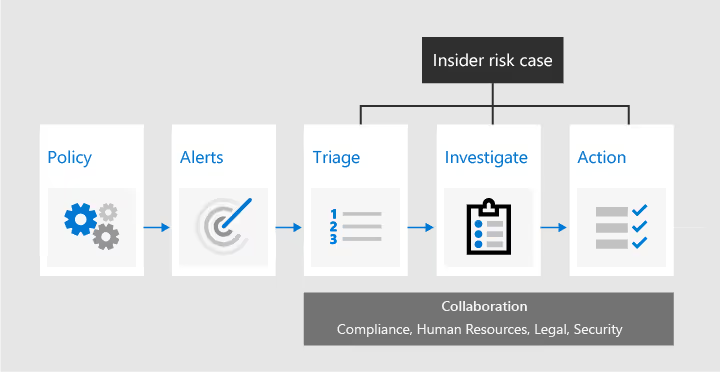10 things to consider for your Microsoft 365 implementation

Table of contents
We know end users can be wary of new tools and processes. So to ensure you have a safe, smooth Microsoft 365 implementation, we listed ten key points to watch out for so everyone stays happy and productive after the changes.
Picture this: end users frowning and rolling their eyes when you announce a change in the tools and services your organization uses to work and collaborate. It means that not only do you have to train employees and ensure new processes are implemented successfully, but you also have to win the team over and ensure that resistance to change won't persist.
Luckily, Microsoft 365 (previously known as Office 365) makes this easy. It's an excellent tool for team collaboration, with the proven capacity to increase productivity while putting a lid on operating costs. But although its capabilities are more or less obvious, the approach toward its implementation is often overlooked.
For your Office 365 implementation to go perfectly, you should consider some critical factors upfront. They're not just technical factors but rather a collection of soft plus technical pain points, based on experience, that organizations might not be aware of before implementation.
Here, we break down ten essential things to consider with your Office 365 implementation (or Microsoft 365, as the brand goes now) and how they can contribute to building effective deployment plans. Let's start!
What's the impact of deploying Microsoft 365?
There's clearly huge potential here for these new suites of products to disrupt an organization's IT ecosystem. When you consider that the Microsoft 365 family of products comes with a unique set of features (and challenges), it becomes evident that the impact of deployment should be carefully considered early on.
Common impacts of this kind of move include:
- The disruption caused by a move to the cloud (if you're moving from an on-premises environment).
- New services might bring along new architecture, like SharePoint communication sites.
- People need to learn new tools, so the learning curve can impact the IT workload.
A clear migration plan must be laid out to deal with this (or any other) kind of impact based on your specific organization's needs. To do this, start by thinking about all work practices that will be affected by the Office 365 deployment, such as how people collaborate. Second, the technical impact of the new environment should be considered, which includes factors such as data management, security, use of third-party tool sets, etc. This should help you calculate migration velocity, and make sure that your organization is set up for success during, and after you're in your new environment.
A new platform for communication and collaboration
With Microsoft 365, you gain access to a new set of tools for communication and collaboration. They bring along powerful and exciting new capabilities that you'll want to leverage to the max.
Take Groups in Microsoft 365: they let you choose certain people that you want to collaborate with and easily set up the resources they need to share in a given tool. If your business needs to collaborate by email and use a shared calendar, you can create a group in Outlook. If your team would rather chat or have video calls, you'll create a Microsoft Team. Or, if you need an open, company-wide discussion forum, you can create a group in Viva Engage (previously called Yammer). Each group will have its set of members, and you can customize settings such as permissions and sharing to make sure that Microsoft 365 is meeting your business requirements.
What does the new Office 365 include?
Users—or at least some of them—will resist new IT tools. So the success of your implementation lies in smoothing out the change process to make resistance as low as possible. Traditionally, this is achieved by training staff and offering help and support as they adjust to the new system, but training on its own is not enough. To start with, let's see what is included with the new Office 365 (now known as Microsoft 365):
- Microsoft SharePoint online
- Microsoft Teams
- OneDrive
- OneNote
- Word
- Excel
- Powerpoint
- Power BI
Check out the full list of Microsoft 365 products here.
Even the smartest technology solutions can be a band-aid
Before we go on sharing the tips that can help drive your success in implementing SharePoint Online & Office 365, we'd like to state one caveat: If you're not solving a problem or improving business processes for your team, then the implementation has failed before it even starts!
If you have a clear vision of how the new system is going to make the business work smarter and quicker, then read on.
But first: if you have any inquiries about Microsoft 365 features like OneDrive for Business and what it can do in the modern workplace, quickly brushing up on the topic can be a great primer.
10 best practices for your new Microsoft 365 implementation
1. Do your best to mitigate all kinds of risks

Of course, saying that you need to take your cloud security seriously seems obvious when you say it out loud. But, consider still that a 2022 IBM security report found that almost 83% of surveyed organizations have had more than one data breach, with cloud-based companies accounting for almost half of such breaches.
This leads us to believe that while data protection and risk management are considered during implementation, they're not well thought out or structured as they should be. The worst part is that such security gaps become evident in hindsight when the damage is already done.
Here are some important data protection and risk management aspects that are often overlooked:
- Identifying security controls—Identify all the security controls you'll need early to monitor your new Microsoft 365 environment effectively. Having effective administrative controls in Microsoft 365 will ensure you stay on top of security.
- Taking full advantage of Azure security features—Azure's security features, such as a web application firewall, conditional access, multi-factor authentication, network layer for network security, etc., come built-in and should be leveraged.
- Monitor guests and external sharing—Oftentimes, it's other organizations you share with and outside collaboration that opens the gates to security threats. Make sure you develop processes to ensure safe external collaboration in Microsoft 365.
- Balancing guardrails with user needs—Remember that the end goal is enabling collaboration and encouraging productivity in your Microsoft 365 environment. So, we encourage adopting self-service to give people the freedom to create things such as teams and sites on their own. To ensure this happens with total security, guardrails such as permissions management, provisioning policies, and sensitive data management are key. This is a win-win approach, where safe collaboration happens while users stay in control.
2. Set up a good communication plan
Users need to trust that IT isn't just embarking on another hare-brained project just for the sake of change.
The best way to secure their buy-in is to effectively communicate how they benefit. Get leaders involved so end-users can see that the business wants and needs the change. Maybe get one of the C-suites to put up a blog or drop in on regular team meetings to give a project overview.
Share simple benefits statements like "Office 365 means that you don't have to log on to the VPN just to check your email" or "You'll be able to recover the previous version of a document you are working on" with the users. Put up posters if you like, or maybe make some short fun videos to promote the benefits of your shiny new Office 365 implementation.
To make this approach even more effective and maximize adoption, think about building an end-user communication strategy. This way, you'll inform changes and engage with people using the right channels for each target audience, making life easier for everyone, end-users and IT alike, and ultimately reducing your ticket queues.
However, a good communication plan doesn't just channel information from the project team to the users: it needs to work both ways. Users should have a clear idea of how they can submit ideas and feedback to the project and then make sure that their ideas are acknowledged, even if you can't implement them. Reward users who come up with great ideas.
3. User adoption starts with education and training

There's this urge to believe that employees will eventually get used to the new way of work without spending too many resources on education and training. However, user adoption isn't just about getting the Office 365 implementation over with and expecting employees to roll with the program.
Keep in mind that most companies are staffed by users who are not (gasp!) tech lovers and who will need to be shown the ropes in a more supportive and structured training environment.
Without the right education and training, employees will struggle with the new tools they now have to use. And it will affect workflow.
More importantly, you should do more than just a simple e-learning program. To motivate employees and ensure they become supporters of the transition, communicate the "why" and not just the "how" of using the new software.
Following best practices when creating cloud migration plan can help employees support organizational change.
4. Empowering end-users and keeping them on your side
User training and the communications plan are necessary, but they're just the beginning.
As we mentioned before, enabling self-service and giving end users more control over what they can do in their new environment will take your Microsoft 365 implementation a step further. The great thing about having the right self-service strategy is that it makes sure end-users don't end up unknowingly messing up the tenant. If you set up the proper guardrails, like automating policies, they'll work with more agility and flexibility without worrying about consulting with IT—and IT won't worry about them. The result? More end-user involvement.
By the way, you might want to learn more about ShareGate's provisioning features. With them, you can provide users with templates so they can create teams by themselves and automate your policies at the same time.
5. Protect your sensitive data

Again, saying that protecting your sensitive data is important is stating the obvious. But, reports show that intruders still manage to get through, and security gaps only become clear after the incident has occurred.
This is why having the right guardrails and governance structure in place from the get-go is crucial. Here are some essential security factors to consider during your Microsoft Office 365 implementation:
- Provisioning
- Permissions management
- Governance
- Reporting
6. Establish Microsoft Teams as everyone's home base

One of the more exciting parts of your new Microsoft 365 environment is the departure from the boring, traditional methods of communication. For example, using e-mail instead of instant chat to ask the most basic question from a teammate can be a dreaded task that consumes a lot of time.
With Teams, you're finally transitioning to the modern workplace where the entire team can gather and communicate in an easy-to-use, centralized hub.
Be ready to use this in your favor and start activities to show everyone how easy it is to send files, make audio/video calls, start group chats, send audio notes, and much more in one place. Once this happens, you should see users embracing their new workspace and establishing Microsoft Teams as their new home base.
There are many reasons why remote teams are going all in on Microsoft's modern workplace. From a better employee experience to efficient collaboration, your organization will have all the right tools to empower every team role.
7. Keeping reporting in mind

Before starting your migration to the cloud, ensure that you have a reporting structure to monitor your new Microsoft 365 environment. A well-thought-out, centralized reporting structure will help avoid unexpected errors, improve performance, respond to active incidents, and decrease support requests, along with many other benefits. Some important aspects to keep in mind in your reports include:
- Policy compliance—Make sure that reports track how well employees are complying with policies. This helps mitigate risk and weed out issues from their roots.
- Apps in use—Users, especially in self-serve environments, will be installing new apps all the time. Monitoring app usage through reports can help ensure security and also help respond to any errors that come up.
- External collaboration—Tracking external collaboration is critical. From monitoring what files are being shared by external users to what information employees send to external collaborators, ensure you can monitor everything.
- Sprawl—Inactive times, unused sites, unnecessary files, and any other kind of data that's adding to clutter will cause security and management issues. Make sure your reports can track this kind of sprawl across your entire Microsoft 365 environment.
8. Ensure ongoing support for your new workplace
Much like Office 365 itself, your project shouldn't ever be "finished." One of the benefits of this departure from traditional project communication is that it'll help everyone understand that implementing SharePoint and, in a broader sense, Office 365 isn't just another IT project. Remember: It's not an evolution, it's a revolution!
There will be future iterations and smaller projects to improve services or roll out new features. And it'll help the entire organization stay on top of enhanced collaboration and productivity.
9. Activate a post-migration plan

Ensuring a super smooth migration process simply doesn't end the moment you migrate to the cloud. A successful migration considers what happens after you're on the cloud but before you've swung open the doors and let everyone in. A post-migration plan should consider aspects such as:
- Governance
- Setting deadlines on old software
- Removing access to the old SharePoint
- Testing all workflows
- Checking user permissions
10. Measure success the right way
The easiest mistake organizations can make is starting off their Microsoft 365 journey without the right definition of success in mind. Most organizations think that the job is done because employees have started using products such as SharePoint Online and Teams, and the IT team is there for support.
But consider this: What if, behind the scenes, everyone is in a reactive state trying to manage what's being thrown at them instead of a proactive approach where processes are well-structured and issues well-managed before they spiral out of control?
We believe your Office 365 implementation is a success when there's a proactive management approach rather than a reactive one. IT shouldn't be scrambling to keep up with support requests. Approaches such as those mentioned in this list, such as having a governance structure in place, preventing sprawl before it happens, monitoring usage, etc., will enable this kind of proactive environment.
Microsoft 365 = Better team collaboration
Implementing Microsoft 365 will undoubtedly have a significant impact on your organization, so you need to do what you can to make sure that impact is as positive as possible.
To sum up, you can minimize the negative impact of a Microsoft 365 implementation in your organization by communicating the benefits to your users, providing the proper support and training before and after the launch of the platform, planning for security, and making it easy for users to provide feedback.
With all that said, ShareGate can ease migration to Microsoft 365 by taking this implementation a step further. Our platform provides Microsoft 365 migration, management, security, and reporting features to enable a proactive environment.
ShareGate is the go-to solution for Microsoft 365 before, during, and after migration, with the best tools for easy and seamless migration. Take a demo and see for yourself!
.jpg)


.svg)
%20(1).avif)












.jpg)


.png)

